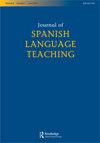重建美国西班牙语教育:美国拉丁语占领教室
Q1 Arts and Humanities
引用次数: 5
摘要
本文旨在通过展示拉丁西班牙语使用者在课堂上的增加如何对西班牙语教学分为三个独立领域的传统方式提出质疑:作为外语,双语教育和作为遗产语言。本文提出,西班牙语教育应关注美国众多拉丁裔的语言表现方式及其语言表现方式的原因。本文探讨了美国西班牙语教育与美国拉丁裔社区种族化的相关历史。然后回顾了西班牙语教育如何将自己构成为三个独立的领域,并分析了今天划分的裂缝。在此基础上,本文提出了重构西班牙语教学的思路,即从消除种族语言意识形态和利用拉丁裔双语社区的译语这两个日益影响少数民族双语学生教育的概念入手。最后,对西班牙语教师提出了一系列实用建议。本文章由计算机程序翻译,如有差异,请以英文原文为准。
Reconstituting U.S. Spanish language education: U.S. Latinx occupying classrooms
This paper aims to rede fi ne Spanish language education in the U.S. by showing how the increased presence of Latinx Spanish-speakers in classrooms brings into question the traditional way in which Spanish language teaching is divided into three, separate fi elds: as a foreign language, in bilingual education, and as a heritage language. It proposes that Spanish language education focuses on the ways in which the numerous U.S. Latinx perform language, and the reasons for their ways of languaging. The article explores the linked histories of Spanish language education in the U.S and racialization of the U.S. Latinx community. A review of how Spanish language education has constituted itself as three separate fi elds is then presented, as the cracks in the divisions today are analyzed. The article then proposes a reconstitution of Spanish language teaching by appropriating two concepts that have been increasingly making inroads in the education of minoritized bilingual students: undoing raciolinguistic ideologies and leveraging the translanguaging of Latinx bilingual communities. It concludes with a series of practical recommendations for Spanish language teachers.
求助全文
通过发布文献求助,成功后即可免费获取论文全文。
去求助
来源期刊

Journal of Spanish Language Teaching
Arts and Humanities-Language and Linguistics
CiteScore
1.80
自引率
0.00%
发文量
11
期刊介绍:
The Journal of Spanish Language Teaching is a new peer-reviewed journal that provides an international forum for innovative research, methods, materials and theories on the teaching and learning of Spanish as a foreign language. The Journal''s main purpose is to create a dialogue between researchers and practitioners worldwide in order to enrich a discipline that is experiencing tremendous growth. The Journal invites contributions from researchers working on topics related to the teaching and learning of the Spanish language at any educational level and in any setting. The Journal will publish original research papers as well as book reviews. Periodically, it will also consider monographic issues and critical surveys of recent research related to a specific sub-discipline or geographical area. A thorough peer review process will be applied to both commissioned and unsolicited articles. The Journal of Spanish Language Teaching will constitute an essential journal of reference in the field. There is currently no other academic publication dedicated solely to the teaching and learning of Spanish, which exists in both print and electronic formats, and is global in its reach. Targeted at both academics and practitioners, the Journal aims to have a major impact on the discipline.
 求助内容:
求助内容: 应助结果提醒方式:
应助结果提醒方式:


